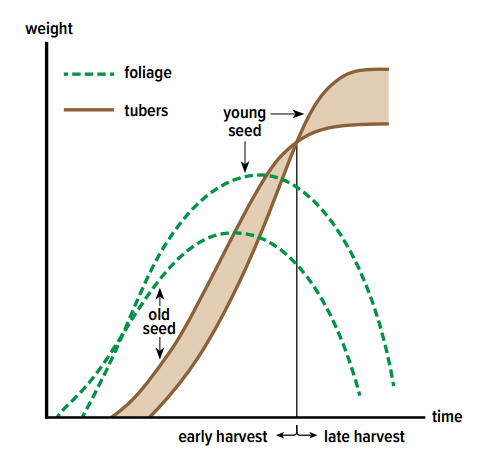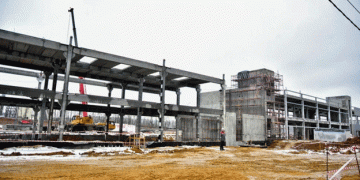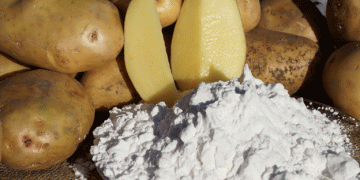#PhysiologicalAge #PotatoCrops #YieldPotential #TuberSize #CropManagement #SeedSpacing #GrowingSeason #Farmers #Agriculture #Optimization
Understanding the physiological age of potato seed plays a crucial role in optimizing crop yield and tuber size. This article explores the significance of physiological age in potato crops, its impact on the growing period, and the resulting consequences. Learn how physiologically younger and older seed varieties are suited to different regions and seasons, and discover practical tips for maximizing yield and tuber size based on physiological age.
Potato crops are greatly influenced by the physiological age of the seed used for cultivation. Physiologically young seed has a longer growing period, offering higher yield potential, while seed with an old physiological age results in a shorter growing period and reduced yield potential. This relationship underscores the importance of selecting appropriate seed varieties based on the desired growing conditions.
Regions with a long growing season are well-suited for physiologically younger seed, as the extended period allows the plants to reach their full potential. On the other hand, regions with a short growing season, characterized by factors such as early frosts, virus incidence, or early markets, benefit from using physiologically older seed.

The growth of foliage and tubers from physiologically young and old seed is illustrated in Figure 2-1. Old seed yields an early harvest, while young seed yields a late harvest. This information, obtained from the Food and Agriculture Organization of the United Nations (FAO) International System for Agricultural Science and Technology (AGRIS), demonstrates the direct impact of physiological age on crop development.
In addition to the growing period, physiological age also affects crop yield and tuber size through the number of stems per area of paddock surface. The number of stems depends on several factors influenced by physiological age. These include the number of eyes per tuber, the number of sprouts per eye, and the number of stems per sprout.
While the number of eyes per tuber is determined by the cultivar, the other two factors are influenced by physiological age. Aged seed typically produces more stems per seed piece, leading to variations in the number and size of tubers produced. Therefore, understanding the physiological age of the seed is essential for optimizing crop management and achieving the best possible yield and tuber size for the target market.
Crop management practices can be adjusted based on the physiological age of the seed to optimize results. When planting physiologically older seed, increasing the seed spacing at planting can reduce the risk of growing too many stems per hectare. This adjustment helps maintain the desired number of stems per area, influencing yield and tuber size.
Considering the physiological age of potato seed has far-reaching consequences for potato farmers. By selecting the appropriate seed variety based on the growing season and region, farmers can maximize their yield potential and optimize tuber size. Moreover, understanding the physiological age allows farmers to fine-tune their crop management practices, such as planter spacing, to achieve the desired outcome.
Crop yield is influenced by various factors, including planter accuracy, soil fertility, soil temperature at planting/tuber initiation, and disease incidence. These factors should be considered in conjunction with physiological age to ensure a successful harvest.
Table 2-2 showcases the effects of seed piece spacing on the number of stems per hectare for seed pieces of different weights and physiological ages. By adjusting seed spacing, farmers can maintain a relatively constant number of stems per hectare, regardless of the physiological age of the seed pieces.
| Table 2-2: Effect of seed piece size and physiological age on number of stems per hill and per hectare with four plant spacings. | ||||||
| Spacing | Seed tonne/ Ha | Stems/ hill | Stems/ Ha | |||
| 2 oz | (56.7 g) | 9 in | (22.86 cm) | 3.01 | 3.1 | 148,303 |
| 2 oz aged | (56.7 g) | 12 in | (30.48 cm) | 2.26 | 4.1 | 147,107 |
| 3 oz | (84.01 g) | 12 in | (30.48 cm) | 3.39 | 3.9 | 139,931 |
| 3 oz aged | (84.01 g) | 15 in | (38.1 cm) | 2.76 | 5.1 | 146,188 |
| 4 oz | (113.4 g) | 12 in | (30.48 cm) | 4.52 | 4.2 | 150,685 |
| 4 oz aged | (113.4 g) | 18 in | (45.72 cm) | 3.01 | 6.2 | 148,303 |
The physiological age of potato seed is of paramount importance in determining crop yield and tuber size. By selecting the appropriate seed variety and adjusting crop management practices based on physiological age, potato farmers can optimize their harvest and meet market demands effectively.






